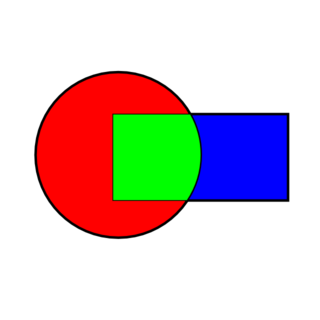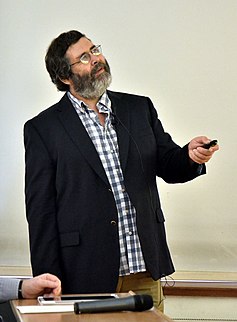Related Research Articles
Numerical methods for partial differential equations is the branch of numerical analysis that studies the numerical solution of partial differential equations (PDEs).
Numerical linear algebra is the study of how matrix operations can be used to create computer algorithms which efficiently and accurately provide approximate answers to mathematical questions. It is a subfield of numerical analysis, and a type of linear algebra. Because computers use floating-point arithmetic, they cannot exactly represent irrational data, and many algorithms increase that imprecision when implemented by a computer. Numerical linear algebra uses properties of vectors and matrices to develop computer algorithms that minimize computer error while retaining efficiency and precision.
Parallel mesh generation in numerical analysis is a new research area between the boundaries of two scientific computing disciplines: computational geometry and parallel computing. Parallel mesh generation methods decompose the original mesh generation problem into smaller subproblems which are solved (meshed) in parallel using multiple processors or threads. The existing parallel mesh generation methods can be classified in terms of two basic attributes:
- the sequential technique used for meshing the individual subproblems and
- the degree of coupling between the subproblems.

In mathematics, numerical analysis, and numerical partial differential equations, domain decomposition methods solve a boundary value problem by splitting it into smaller boundary value problems on subdomains and iterating to coordinate the solution between adjacent subdomains. A coarse problem with one or few unknowns per subdomain is used to further coordinate the solution between the subdomains globally. The problems on the subdomains are independent, which makes domain decomposition methods suitable for parallel computing. Domain decomposition methods are typically used as preconditioners for Krylov space iterative methods, such as the conjugate gradient method or GMRES.
In numerical analysis, the balancing domain decomposition method (BDD) is an iterative method to find the solution of a symmetric positive definite system of linear algebraic equations arising from the finite element method. In each iteration, it combines the solution of local problems on non-overlapping subdomains with a coarse problem created from the subdomain nullspaces. BDD requires only solution of subdomain problems rather than access to the matrices of those problems, so it is applicable to situations where only the solution operators are available, such as in oil reservoir simulation by mixed finite elements. In its original formulation, BDD performs well only for 2nd order problems, such elasticity in 2D and 3D. For 4th order problems, such as plate bending, it needs to be modified by adding to the coarse problem special basis functions that enforce continuity of the solution at subdomain corners, which makes it however more expensive. The BDDC method uses the same corner basis functions as, but in an additive rather than multiplicative fashion. The dual counterpart to BDD is FETI, which enforces the equality of the solution between the subdomain by Lagrange multipliers. The base versions of BDD and FETI are not mathematically equivalent, though a special version of FETI designed to be robust for hard problems has the same eigenvalues and thus essentially the same performance as BDD.
In mathematics, Neumann–Neumann methods are domain decomposition preconditioners named so because they solve a Neumann problem on each subdomain on both sides of the interface between the subdomains. Just like all domain decomposition methods, so that the number of iterations does not grow with the number of subdomains, Neumann–Neumann methods require the solution of a coarse problem to provide global communication. The balancing domain decomposition is a Neumann–Neumann method with a special kind of coarse problem.
In mathematics, the Neumann–Dirichlet method is a domain decomposition preconditioner which involves solving Neumann boundary value problem on one subdomain and Dirichlet boundary value problem on another, adjacent across the interface between the subdomains. On a problem with many subdomains organized in a rectangular mesh, the subdomains are assigned Neumann or Dirichlet problems in a checkerboard fashion.
In numerical analysis, mortar methods are discretization methods for partial differential equations, which use separate finite element discretization on nonoverlapping subdomains. The meshes on the subdomains do not match on the interface, and the equality of the solution is enforced by Lagrange multipliers, judiciously chosen to preserve the accuracy of the solution. Mortar discretizations lend themselves naturally to the solution by iterative domain decomposition methods such as FETI and balancing domain decomposition In the engineering practice in the finite element method, continuity of solutions between non-matching subdomains is implemented by multiple-point constraints.
In mathematics, the abstract additive Schwarz method, named after Hermann Schwarz, is an abstract version of the additive Schwarz method for boundary value problems on partial differential equations, formulated only in terms of linear algebra without reference to domains, subdomains, etc. Many if not all domain decomposition methods can be cast as abstract additive Schwarz method, which is often the first and most convenient approach to their analysis.

Jan Mandel is a Czech-American mathematician. He received his PhD from the Faculty of Mathematics and Physics, Charles University in Prague and was a Senior Research Scientist there. Since 1986, he is professor of Mathematics at the University of Colorado Denver. Since 2013, he is senior scientist at the Institute of Computer Science of the Czech Academy of Sciences.

Charbel Farhat is the Vivian Church Hoff Professor of Aircraft Structures in the School of Engineering at Stanford University, where he is also Chairman of the Department of Aeronautics and Astronautics, Professor of Mechanical Engineering, Professor in the Institute for Computational and Mathematical Engineering, and Director of the King Abdulaziz City for Science and Technology Center of Excellence for Aeronautics and Astronautics. He also serves on the Space Technology Industry-Government-University Roundtable. From 2007 to 2018, he served as the Director of the Army High Performance Computing Research Center at Stanford University, and from 2015 to 2018, on the United States Air Force Scientific Advisory Board (SAB). He has previously served on the technical assessment boards of several national and international research councils and foundations, and on the United States Bureau of Industry and Security's Emerging Technology and Research Advisory Committee (ETRAC) at the United States Department of Commerce.
In numerical analysis, coarse problem is an auxiliary system of equations used in an iterative method for the solution of a given larger system of equations. A coarse problem is basically a version of the same problem at a lower resolution, retaining its essential characteristics, but with fewer variables. The purpose of the coarse problem is to propagate information throughout the whole problem globally.
In mathematics, a Poincaré–Steklov operator maps the values of one boundary condition of the solution of an elliptic partial differential equation in a domain to the values of another boundary condition. Usually, either of the boundary conditions determines the solution. Thus, a Poincaré–Steklov operator encapsulates the boundary response of the system modelled by the partial differential equation. When the partial differential equation is discretized, for example by finite elements or finite differences, the discretization of the Poincaré–Steklov operator is the Schur complement obtained by eliminating all degrees of freedom inside the domain.
The Sidney Fernbach Award established in 1992 by the IEEE Computer Society, in memory of Sidney Fernbach, one of the pioneers in the development and application of high performance computers for the solution of large computational problems as the Division Chief for the Computation Division at Lawrence Livermore Laboratory from the late 1950s through the 1970s. A certificate and $2,000 are awarded for outstanding contributions in the application of high performance computers using innovative approaches. The nomination deadline is 1 July each year.
Yousef Saad is an I.T. Distinguished Professor of Computer Science in the Department of Computer Science and Engineering at the University of Minnesota. He holds the William Norris Chair for Large-Scale Computing since January 2006. He is known for his contributions to the matrix computations, including the iterative methods for solving large sparse linear algebraic systems, eigenvalue problems, and parallel computing. Saad is listed as an ISI highly cited researcher in mathematics and is the author of the highly cited book Iterative Methods for Sparse Linear Systems. Yousef Saad is a SIAM fellow and a fellow of the AAAS (2011).
Dynamic Substructuring (DS) is an engineering tool used to model and analyse the dynamics of mechanical systems by means of its components or substructures. Using the dynamic substructuring approach one is able to analyse the dynamic behaviour of substructures separately and to later on calculate the assembled dynamics using coupling procedures. Dynamic substructuring has several advantages over the analysis of the fully assembled system:
References
- ↑ C. Farhat, M. Lesoinne, P. LeTallec, K. Pierson, and D. Rixen, FETI-DP: a dual-primal unified FETI method. I. A faster alternative to the two-level FETI method, Internat. J. Numer. Methods Engrg., 50 (2001), pp. 1523--1544.
- ↑ J. Mandel and R. Tezaur, On the convergence of a dual-primal substructuring method, Numerische Mathematik, 88 (2001), pp. 543--558.
- ↑ C. Farhat, M. Lesoinne, and K. Pierson, A scalable dual-primal domain decomposition method, Numer. Linear Algebra Appl., 7 (2000), pp. 687--714. Preconditioning techniques for large sparse matrix problems in industrial applications (Minneapolis, MN, 1999).
- ↑ A. Klawonn, O. B. Widlund, and M. Dryja, Dual-primal FETI methods for three-dimensional elliptic problems with heterogeneous coefficients, SIAM J. Numer. Anal., 40 (2002), pp. 159--179.
- ↑ J. Mandel, C. R. Dohrmann, and R. Tezaur, An algebraic theory for primal and dual substructuring methods by constraints, Appl. Numer. Math., 54 (2005), pp. 167--193.
- ↑ Manoj Bhardwaj, Kendall H. Pierson, Garth Reese, Tim Walsh, David Day, Ken Alvin, James Peery, Charbel Farhat, and Michel Lesoinne. Salinas: A scalable software for high performance structural and mechanics simulation. In ACM/IEEE Proceedings of SC02: High Performance Networking and Computing. Gordon Bell Award, pages 1–19, 2002.
- ↑ Klawonn, A.; Rheinbach, O., "Highly scalable parallel domain decomposition methods with an application to biomechanics", Journal of Applied Mathematics and Mechanics , 90 (1): 5–32, doi:10.1002/zamm.200900329 .
| This applied mathematics-related article is a stub. You can help Wikipedia by expanding it. |